Giant Clams Identification 101
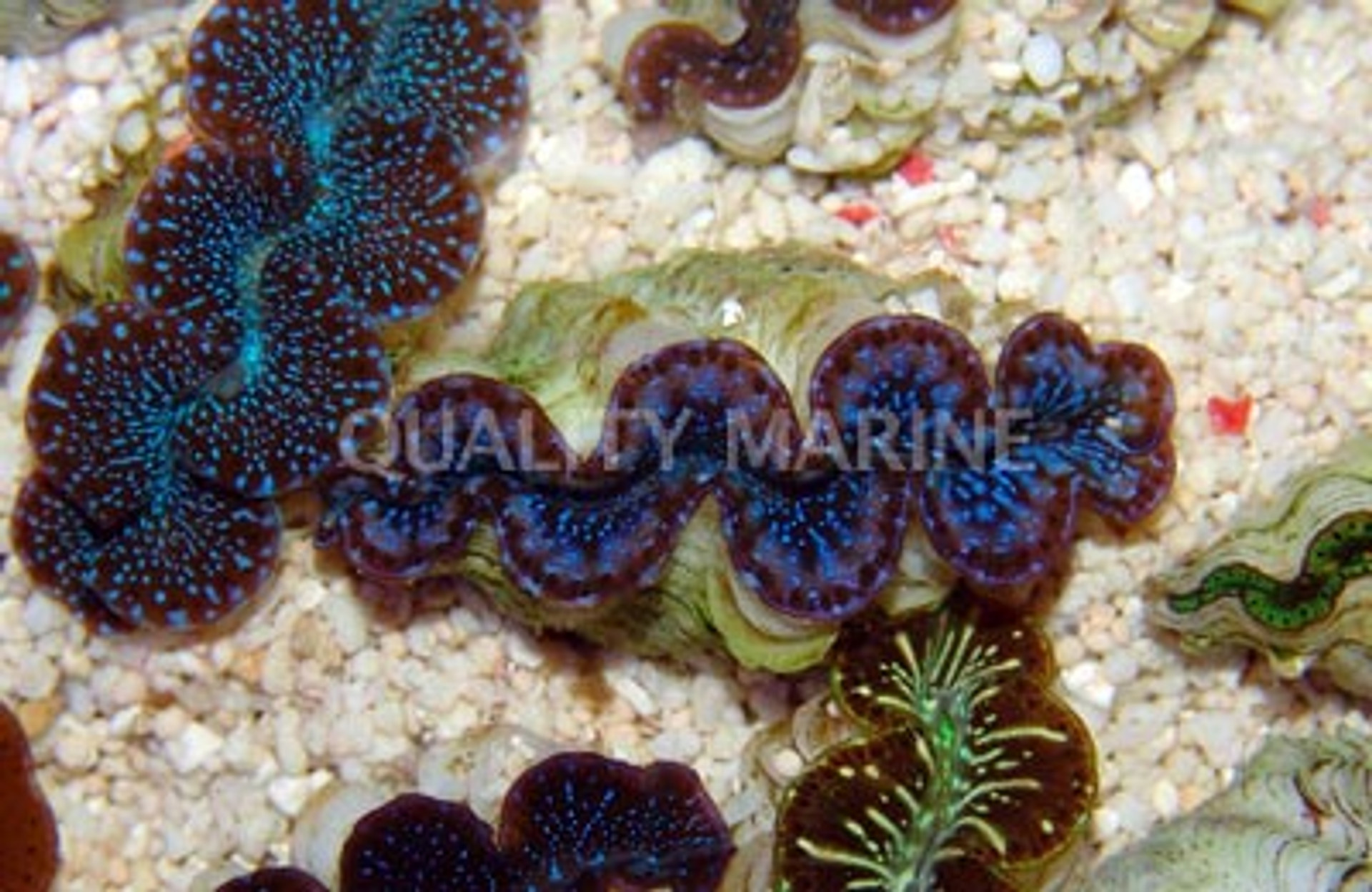
Giant clams are undeniably one of the coolest things about coral reefs, and no reef tank is ever really complete without one. But it helps to do a bit of homework before adding one of these to an aquarium, as the care requirements and ultimate size of these species can be dramatically different. Not all giant clams are truly giants, and they dont always need bright light to thrive. So lets take a brief tour through this group and meet some of the exciting offerings found at Quality Marine...
Tridacna gigas
The true giant clam is the appropriately named T. gigas, the largest specimens of which have been recorded at over four feet in shell length and weighing more than 500 pounds. Of course, it takes quite a while (a few decades?) for this monstrous mollusk to reach these dimensions, but, eventually, only the very largest of aquariums can ever hope to hold a mature specimen longterm. Due to these limitations, this is also one of the less commonly available species in the aquarium trade, though it is widely aquacultured for other purposes.
Uniquely among the giant clams, T. gigas is unable to close its shell fully. It also has a distinctive appearance to its fleshy mantle, having a dense array of blue eyes (technically speaking, the hyaline organs) scattered about the darkly colored tissue. Its rare to find truly colorful examples of this species, with most being some shade of tan or brown or mauve, though some might veer more towards a shade of blue or green, particularly around the perimeter. The tissue itself tends to have a strangely wrinkled quality to it, quite unlike anything else in this genus. The shell has 4-5 ribs which are relatively smooth and strongly folded. If youre crazy enough to put one of these in an aquarium, youll want to place it on the sand and give it plenty of room to grow.
Tridacna derasa
This is one of the easier clams to recognize, and its also one of the largest, able to reach upwards of two feet in shell length. Look for a fairly smooth shell with 6-7 weakly formed ribs, and with a mantle that barely extends beyond the edge. Color and patterning of the mantle can vary pretty wildly in T. derasa, but one useful trait to look for is a thin band of teal-colored tissue along the perimeter, which is where the tiny black eyes are lined up. Some specimens will lack the contrasting tissue, but theyll still have the eyes neatly arranged in that location. Common color variants include those that are a light tan with blue margin or dark specimens with blue or white striations running lengthwise or those that are strongly mottled. And sometimes you can find all of these patterns combined in a single clam.
This species occurs throughout the West Pacific, and it is tolerant of lower light levels in captivity, having been recorded as far down as 25 meters!
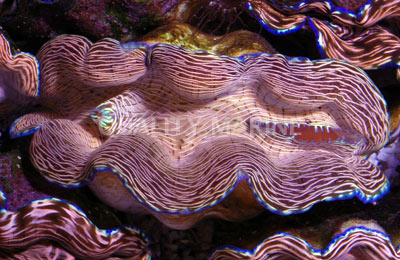
Tridacna squamosa
Next we have T. squamosa, which grows to a respectable 16 inches. It has a broad distribution that includes the Red Sea to South Africa and east throughout the West Pacific. The scientific name of this one comes from the Latin for scaled and refers to the prominent scutes that project out from the symmetrically shaped shell. Other species have these to varying extent, with T. maxima being the species most likely to be confused here, but none can compare to a large T. squamosa. Even the juveniles seen in the aquarium trade are readily identified in this way. Coloration in this species tends towards a mottled brown, or sometimes a mottled blue, but the mythic Blue Squamosa is also seen on rare occasion.
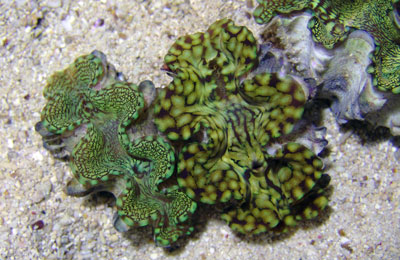
This is another easy to keep species that needs relatively modest amounts of lights. Large specimens are best placed on sand, while juveniles can be allowed to attach their byssal threads to a small piece of rock and be moved about with ease.
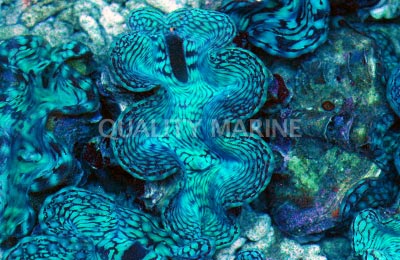
Tridacna maxima
The most variable and widespread of the giant clams is T. maxima. It is the only member of this group found across the whole of the tropical Indo-Pacific (with the exception of Hawaii, where the group never seems to have made it). Given how variable the colors are in this clam, its often best to identify it by the morphology of the shell and mantle. The eyes are similar to those seen in T. derasa, being densely arranged in a line around the perimeter. The shell can reach around 9 inches and has 4-6 ribs, covered with scutes that are smaller and more numerous than those found in T. squamosa.
In recent years, genetic study has revealed the presence of a cryptic species that had been confused with T. maxima. Aquarists long recognized this unique variant as the Teardrop Maxima, referring to the distinctive ovular markings of the mantle that radiate outwards like sad clam teardrops. It was only in 2014 that this form was elevated to its own species,
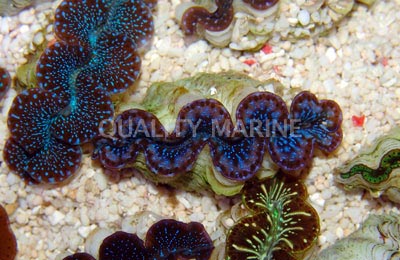
T. noae, though this name was actually first used way back in 1798! Both forms require relatively high light in aquariums and will attach firmly to rocks using their byssal threads.
Tridacna crocea
The baby of the group, growing to just 6 inches, is T. crocea, a species common in the shallowest reefs of the West Pacific. On the reef, this species is distinctive for its burrowing nature, using acids it is capable of secreting, combined with the physical grinding of its shell, to produce a hole in which it resides. Usually the only visible part of this clam will be the extended mantle, which is arguably the most colorful of any of the giant clams. The shell has 6-10 weak, smooth ribs, giving it a somewhat derasa-like appearance (though the two are otherwise very different). The eyes are widely scattered, which can help in separating this species from T. maxima.
Due to its preference for the shallowest of coral reefs, T. crocea is arguably the most challenging of the giant clams to keep happy in an aquarium, though this hasnt kept it from being among the most popular. Strong illumination is called for, though, on the plus side, its smaller dimensions mean that this little
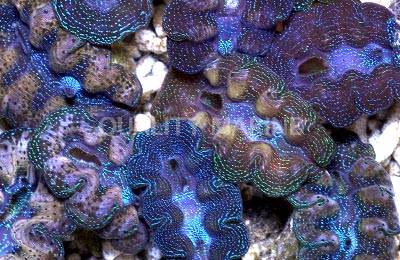
Tridacna requires considerably less calcium and alkalinity to be dosed.
Hippopus hippopus
And lets not forget Hippopus, the Bear Claw Clam the Horses Hoof Clam the Strawberry Clam. This unmistakable West Pacific species can reach a respectably giant size of roughly a foot and a half. Its highly symmetrical shell can have more than a dozen ribs; however, it can be hard to accurately count these owing to the many other wavy indentations in the shell. While their are no scutes as we see in Tridacna, smaller specimens often have small, rounded protuberances placed sporadically. And the shell itself has quite a bit of color in most specimens, with shades of red or orange forming irregular wavy patterns that run lengthwise.
The tissue is generally some shade of brown or yellow-brown of green-brown, and it is completely unable to extend beyond the edge of the shell. In contrast to most Tridacna, there are no tentacles protruding into the inhalent siphon, though the rarely seen China Clam (H. porcellanus) does have these.
Aquarium care is relatively undemanding, requiring moderate light levels.